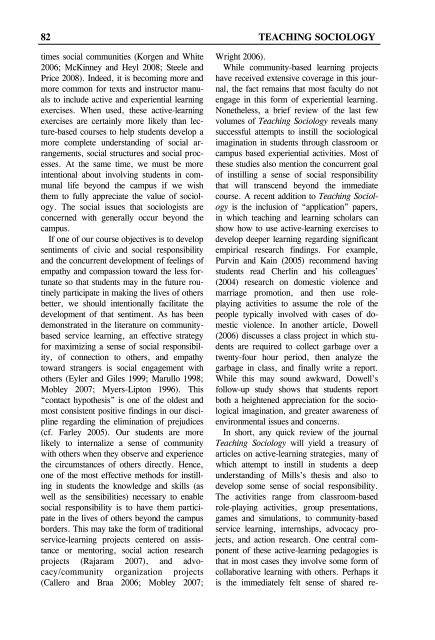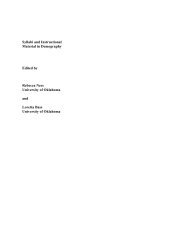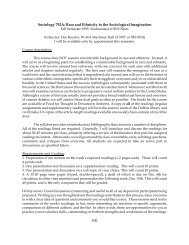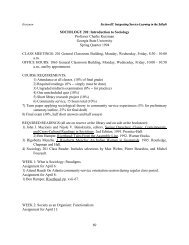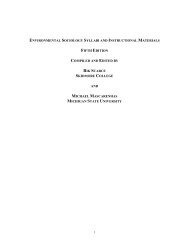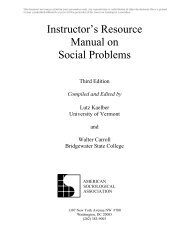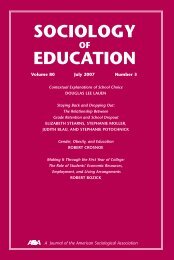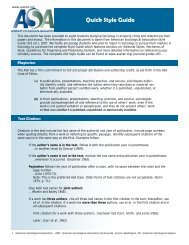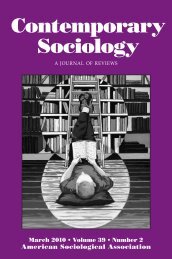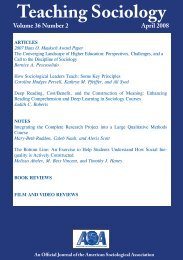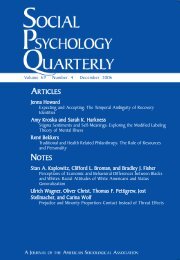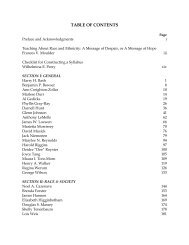Teaching Sociology - American Sociological Association
Teaching Sociology - American Sociological Association
Teaching Sociology - American Sociological Association
Create successful ePaper yourself
Turn your PDF publications into a flip-book with our unique Google optimized e-Paper software.
82 TEACHING SOCIOLOGY<br />
times social communities (Korgen and White<br />
2006; McKinney and Heyl 2008; Steele and<br />
Price 2008). Indeed, it is becoming more and<br />
more common for texts and instructor manuals<br />
to include active and experiential learning<br />
exercises. When used, these active-learning<br />
exercises are certainly more likely than lecture-based<br />
courses to help students develop a<br />
more complete understanding of social arrangements,<br />
social structures and social processes.<br />
At the same time, we must be more<br />
intentional about involving students in communal<br />
life beyond the campus if we wish<br />
them to fully appreciate the value of sociology.<br />
The social issues that sociologists are<br />
concerned with generally occur beyond the<br />
campus.<br />
If one of our course objectives is to develop<br />
sentiments of civic and social responsibility<br />
and the concurrent development of feelings of<br />
empathy and compassion toward the less fortunate<br />
so that students may in the future routinely<br />
participate in making the lives of others<br />
better, we should intentionally facilitate the<br />
development of that sentiment. As has been<br />
demonstrated in the literature on community-<br />
based service learning, an effective strategy<br />
for maximizing a sense of social responsibility,<br />
of connection to others, and empathy<br />
toward strangers is social engagement with<br />
others (Eyler and Giles 1999; Marullo 1998;<br />
Mobley 2007; Myers-Lipton 1996). This<br />
“contact hypothesis” is one of the oldest and<br />
most consistent positive findings in our discipline<br />
regarding the elimination of prejudices<br />
(cf. Farley 2005). Our students are more<br />
likely to internalize a sense of community<br />
with others when they observe and experience<br />
the circumstances of others directly. Hence,<br />
one of the most effective methods for instilling<br />
in students the knowledge and skills (as<br />
well as the sensibilities) necessary to enable<br />
social responsibility is to have them participate<br />
in the lives of others beyond the campus<br />
borders. This may take the form of traditional<br />
service-learning projects centered on assistance<br />
or mentoring, social action research<br />
projects (Rajaram 2007), and advocacy/community<br />
organization projects<br />
(Callero and Braa 2006; Mobley 2007;<br />
Wright 2006).<br />
While community-based learning projects<br />
have received extensive coverage in this journal,<br />
the fact remains that most faculty do not<br />
engage in this form of experiential learning.<br />
Nonetheless, a brief review of the last few<br />
volumes of <strong>Teaching</strong> <strong>Sociology</strong> reveals many<br />
successful attempts to instill the sociological<br />
imagination in students through classroom or<br />
campus based experiential activities. Most of<br />
these studies also mention the concurrent goal<br />
of instilling a sense of social responsibility<br />
that will transcend beyond the immediate<br />
course. A recent addition to <strong>Teaching</strong> <strong>Sociology</strong><br />
is the inclusion of “application” papers,<br />
in which teaching and learning scholars can<br />
show how to use active-learning exercises to<br />
develop deeper learning regarding significant<br />
empirical research findings. For example,<br />
Purvin and Kain (2005) recommend having<br />
students read Cherlin and his colleagues’<br />
(2004) research on domestic violence and<br />
marriage promotion, and then use roleplaying<br />
activities to assume the role of the<br />
people typically involved with cases of domestic<br />
violence. In another article, Dowell<br />
(2006) discusses a class project in which students<br />
are required to collect garbage over a<br />
twenty-four hour period, then analyze the<br />
garbage in class, and finally write a report.<br />
While this may sound awkward, Dowell’s<br />
follow-up study shows that students report<br />
both a heightened appreciation for the sociological<br />
imagination, and greater awareness of<br />
environmental issues and concerns.<br />
In short, any quick review of the journal<br />
<strong>Teaching</strong> <strong>Sociology</strong> will yield a treasury of<br />
articles on active-learning strategies, many of<br />
which attempt to instill in students a deep<br />
understanding of Mills’s thesis and also to<br />
develop some sense of social responsibility.<br />
The activities range from classroom-based<br />
role-playing activities, group presentations,<br />
games and simulations, to community-based<br />
service learning, internships, advocacy projects,<br />
and action research. One central component<br />
of these active-learning pedagogies is<br />
that in most cases they involve some form of<br />
collaborative learning with others. Perhaps it<br />
is the immediately felt sense of shared re-


